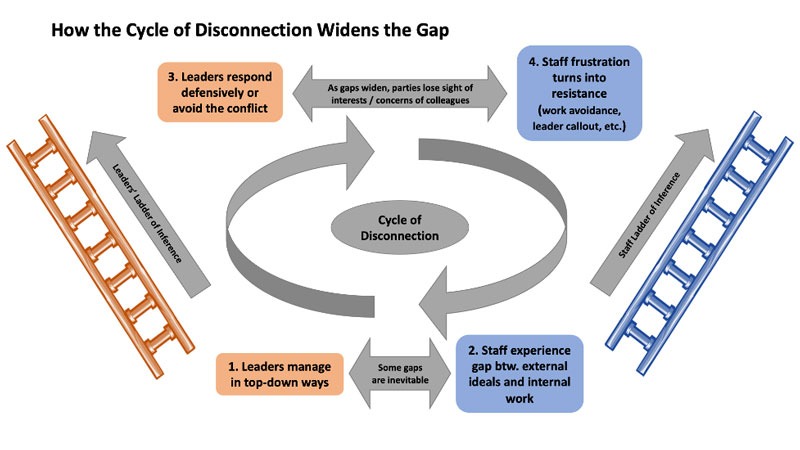
Contributors include Corita Brown, Marissa Graciosa, Claudia Horwitz, Flavia Jimenez, Susan Misra, Dax-Devlon Ross, Lisa Russ, Sean Thomas-Breitfeld, and Marian Urquilla
Last summer, a multiracial, multigenerational group of over 25 coaches, consultants, and capacity builders started meeting in response to our shared sense that internal conflicts at progressive organizations were undermining social justice movements. As part of this work, we rigorously read and discussed Maurice Mitchell’s article about key trends and fallacies in progressive movement organizations and the dimensions of organizational resilience needed to win. We feel compelled to add to the critical conversation Mitchell has sparked by sharing our reflections, primarily as an invitation to other coaches, consultants, and capacity builders to sharpen our collective analysis, skillfulness, and accountability in working with organizations. We also hope that our reflections help organizations, staff, and leaders themselves apply these lessons to their own context.
The fundamental pattern that we observe, particularly in progressive movement organizations but in other parts of the nonprofit sector, too, is a vicious cycle of disconnection between staff and leaders that often drives “us versus them” dynamics, exacerbates mistrust, and grinds work to a halt.
We offer four interlocking observations:
- There is a fundamental cycle of disconnection that is driving leaders and staff apart.
- Escaping this cycle requires stakeholders to discuss and reach mutual understanding about three core concepts foundational to progressive organizations.
- It also requires that coaches, consultants, and capacity builders recognize and cease practices that have unwittingly contributed to this cycle of disconnection.
- To interrupt these patterns in the future, we as coaches, consultants, and capacity builders must cultivate three key skills in ourselves as well as in leaders and staff.
Finally, we offer a practical assessment at the end of this article with concrete questions to help organizations and individuals develop shared understanding and skills needed to break the cycle of disconnection.
I. Cycle of Disconnection
The fundamental pattern that we observe, particularly in progressive movement organizations but in other parts of the nonprofit sector, too, is a vicious cycle of disconnection between staff and leaders that often drives “us versus them” dynamics, exacerbates mistrust, and grinds work to a halt. This pattern renders progressive organizations ineffective for the communities most directly impacted by the resurgent right-wing, authoritarian, White supremacist, patriarchal, anti-LGBTQ+, and anti-environmental movements.
The cycle of disconnection is often set in motion when ideals about movement work are dashed by the reality of nonprofit workplaces. Staff, particularly those newer to the workforce, have expectations informed and shaped by rhetoric about the societal changes organizations seek (for example “centering those most impacted,” “breaking norms of White supremacy,” and so on). However, those progressive values sometimes rub against the tendency of leaders to enact traditional management and governance practices, particularly as the size, scale, and complexity of organizations grow.
As the cycle of disconnection causes tensions to rise, staff and leaders grow further apart and climb up their own “ladder of inference” (Chris Argyris and Peter Senge, The Fifth Discipline, 1994). Each camp begins making assumptions about the other, behaves as if those assumptions are true, and ends up in greater opposition to the other. For staff, frustrations over the gaps between public rhetoric and internal operations can lead to public callouts of leadership, open letters, and work avoidance. These forms of staff resistance often trigger fears among leadership about losing issue campaigns, falling short on base building or turnout metrics, and other reputational risks. Sometimes leaders remain silent or do not respond directly to staff concerns in a misguided attempt to avoid conflict. Other times, leaders respond defensively and increase their reliance on the very top-down management tactics that staff are reacting to in the first place (for example, holding decision-making about big things—budget, expanding or sunsetting programs, hiring and firing—at the most senior levels). These patterns of entrenchment perpetuate the disconnect staff experience between their aspirations and the reality of the workplace. Rinse and repeat.

From the top of each group’s ladder of inference, where staff and leaders have inferred different meanings about choices made by the other group, each can lose sight of the underlying and real challenges facing their colleagues. Many leaders fail to appreciate the very real economic precarity of a generation saddled with debt and financial insecurity—which directly informs demands for higher salaries and professional development—not to mention their genuine desire for meaning, belonging, and political homes that mirror their values and ideals, as manifested through things like organizational structure and decision-making practices. The increasing prevalence of staff unionization is evidence of these felt needs among staff. And many staff fail to appreciate that leaders in the organizations are also trying to find meaning, make values-aligned choices for themselves and their organizations, and navigate a complex sector. Understanding leaders, as Mitchell says, is something our movements do not do well. Further adding to the distance, staff often see organizational leaders as holding and seeking to retain ultimate power, without awareness that leaders’ autonomy is actually limited. Leaders are accountable to many stakeholders who may not be visible to staff, including donors, board members, auditors, and the IRS, in a sector where relentless competition for grants and donors, as well as legal restrictions, are defining features. These dynamics create demanding burdens on leaders’ time and attention and limit their ability to make wholesale changes that they might wish to make but cannot due to constraints from less visible stakeholders.
In this period of widespread turmoil, consultants, coaches, and capacity builders must help organizations build a nuanced understanding of what is going on, identify bright spots, gaps, and missteps, and craft and sequence actions to stabilize and evolve organizational dynamics.
II. Core Concepts for Mutual Understanding
In this period of widespread turmoil, consultants, coaches, and capacity builders must help organizations build a nuanced understanding of what is going on, identify bright spots, gaps, and missteps, and craft and sequence actions to stabilize and evolve organizational dynamics. While coaches, consultants, and capacity builders share the responsibility for implementing organizational change with other stakeholders—staff, managers, executive directors, board members, donors and funders, members, and constituents—providing a clear analysis of conflict and how to move toward resolution is a role that we are uniquely positioned to occupy from outside the organizational system. While mediation and restorative justice, as well as dismantling racist practices, can be successful in some organizations, unless there is alignment around some fundamentals the cycle is likely to persist.
In our work, we see three core concepts that must be named and navigated explicitly if organizations are to build the kind of mutual understanding—specifically between staff and leaders—essential for breaking the cycle of disconnection.
- The first core concept is that while nonprofit organizations are part of social movements, they are not the same thing. The power of nonprofit organizations is directly related to the power of social movements, and vice versa. Each has a particular and important role to play in advancing social change, but they are distinct. Nonprofits pay staff members to do the work of organizing, advocacy, strategic communication, research, and more that creates the necessary infrastructure to harness movement energy productively. Social movements are fluid; they adapt how they mobilize everyday people as movement energy crests and falls. When a community member doesn’t show up to a meeting or protest, a successful movement still has enough of a base to have a successful action. Progressive nonprofits, on the other hand, while being a vital part of social movements, play a different and more consistent role, regardless of external events. When a nonprofit staff member doesn’t show up or follow through on their work, the impact is felt throughout the organization and, when added up over time, can weaken the movement the nonprofit exists to support.
Nonprofits must also be clear about their role in a particular movement and how their own power and success or failure impact the movements they support. If nonprofit organizations are silent on this point, their efforts to build and grow their organization may be perceived as purely self-interested and disconnected from goals of building power of the broader movement.
- The second and related critical concept organizations need to grapple with is that work is a social contract between employer and employee, with responsibilities each must fulfill. Across sectors, there is an emerging difference in how workers and employers understand the responsibility and accountability for “work.” People are often drawn to work in a movement-supporting nonprofit because of their connection to movement work and values, which can lead one to feel that their work is “more than a job.” But while nonprofit organizational work can be—and ideally is—enormously rewarding, it remains fundamentally a contractual exchange of an employee’s time and labor for their paycheck and employment benefits.
Especially in this era of increased remote work, it has never been more important for both employers and employees to clarify expectations. On the employer side, this certainly requires transparency about salary and basic benefits (such as health insurance, paid time off, and retirement contributions). But for organizations on the frontlines of movement work, it also behooves employers to consider the commitments and accommodations they can make to support staff mental health and overall wellness. It is vital to remember that while all staff have been affected by today’s tumultuous social and political environment, staff of color have been disproportionately impacted by the pandemic, the erosion of democratic norms, and continued state violence against Black people in particular.
Sign up for our free newsletters
Subscribe to NPQ's newsletters to have our top stories delivered directly to your inbox.
By signing up, you agree to our privacy policy and terms of use, and to receive messages from NPQ and our partners.
Clarifying expectations also requires that employers be honest in their responses to common questions and concerns raised by employees about workplace culture and practices. Employers should be clear with staff about
-
- how important decisions get made
- what information is shared or held confidential, and why
- when staff are informed rather than consulted, and why
- on what basis their work will be evaluated and the consequences if their work does not meet expectations
On the employee side, this means
-
- being explicit about constraints due to their personal contexts
- conditions needed for them to perform well
- anything else that might impact their ability to keep their end of the contract
It means asking probing questions during the interview process to help evaluate if the organization’s values align with the employee’s individual values. And it means understanding and negotiating pay, working hours, and workplace expectations, and learning about decision-making and reporting relationships, ideally before accepting a position.
Both parties must feel the basic contract is fair upfront and acknowledge that they have a responsibility to uphold their end of the bargain. It is worth saying explicitly that this includes the basics of the contract—from paying people on time and granting paid time off for people to tend to their personal needs (on the employer side) to performing the responsibilities of the job during agreed-upon work hours and using paid time off for personal pursuits rather than the other way around (on the employee side). And both employers and employees must be prepared to name and address any gaps between the contractual agreement—whether verbal or written—and the reality of work. For employers, this means ensuring that the organization has clear and fair processes for handling employee complaints about working conditions, and transparent ways to address managerial failures to uphold the organization’s values and policies. This is a higher level of commitment than creating policies to protect the organization from legal liabilities. For employees, this means raising any gaps between agreed-upon expectations and their experience to managers, using organizational processes to handle complaints, and escalating if those processes do not exist or are not utilized.
- The third core concept is that each progressive organization has its own history, ideology, and positioning within a broader movement or field. As Maurice Mitchell highlights, many organizations are not clear enough—both externally and with their staff—about where they come from, who they are, what they are trying to do, and why. All too often, the unique context, political identity, and purpose of our organizations blur with the passage of time—or maybe they were never clarified. The trend of shorter job tenures means that fewer people in organizations are likely to have a historical perspective about where their organization is situated in a larger movement ecosystem, what it was founded to do, and how and why it carries that work out. Even nonprofits that do political education as part of their community organizing often fail to engage their staff in nuanced dialogue about the ideology that informs the organization’s principled political action and inevitable compromises.
When leaders are not explicit about what underlies and informs the organization’s work, individuals understandably project their own beliefs or assumptions onto that organization. When staff enter an organization with assumptions that do not align with the reality of the organization’s work, the cycle of disconnection gets revved up, often leading to destructive outcomes for staff, leaders, organizations, and movements themselves. Making the implicit explicit here is an essential step in breaking that cycle.
III. Recognizing Our Contributions to the Challenges
As progressive nonprofits struggle to recalibrate the social contract between employees, leaders, and the institutions they make up, we, as coaches, consultants, and capacity builders, are also seeking to recalibrate our work. We are hardly blameless nor immune from participating in and exacerbating the cycle of disconnection. While we are continuing to reflect on our approaches and methods and explore how we can hold ourselves and one another accountable to best practices moving forward, we have begun to name the ways that we and others in our sector have contributed to organizational challenges. Specifically, we have sometimes been unbalanced, unregulated, and unprincipled.
- We are unbalanced when we favor one side over another and do not hold the whole, including when we are:
- Overly deferential and accountable to leadership, instead of relating directly to staff, constituents, and impacted communities.
- Too enamored with maxims, catchphrases, or trends, such as the reductionist use of “White supremacy culture” and other terms and frameworks that tend to lose clarity and specificity as they gain ubiquity.
- More concerned about how we are perceived, or afraid of being called out, than our accountability to our organizational client or what impact we are having on the sector as a whole.
- We are unregulated when we act from our own trauma or triggers, including when we are:
- Contributors to hustle culture by playing into client urgency and leaning into hypervigilance, for example, by trying to solve problems with easy fixes that don’t consider the complexity of the situation, or operating from a scarcity mindset and uncritically taking on contracts without considering if we are the best fit for the client’s needs.
- Practitioners of saviorism by trying to solve all the problems rather than facilitating people to arrive at solutions themselves that work for them or embedding ourselves as quasi staff and losing our boundary role.
- Unable to take the heat and bowing out when we could be finding and modeling more inner equanimity.
- Silent around maximalist, overblown, or other trauma responses when we see them—and then replicating them ourselves, or not naming the need for boundaries and additional support.
- We are unprincipled when we do not act with integrity or in alignment with our commitment to disrupting racism and oppression of all forms, including when we are:
- Inattentive to historical ghosts and harms, such as the racist underpinnings of certain movements, racial injustice within progressive organizations, and the ways in which leaders of color are being held accountable for organizational legacies by staff impatient for transformation.
- Perpetrators of the status quo by doing what we’ve always done, how we’ve done it.
- Silent about the inherent contradiction in coaching and consulting work: the more problems there are, the more we are in demand.
IV. Skills Needed to Break the Cycle, Build Mutual Understanding, and Win
We see three key skills that we have a responsibility as coaches, consultants, and capacity builders to both cultivate in ourselves and help develop in our work with staff and leaders. We believe these skills will enable all of us to help break the cycle of disconnection, build mutual understanding around core concepts, and move forward together to win.
- First, we must develop the ability to engage in productive and transformative conflict. Many before us have powerfully made this point (see here, here, and here for example). And, we have seen enough degenerative conflict emerge in recent years that we want to elevate it as the most critical skill for ourselves, as well as progressive leaders and staff (and their board members and donors) to develop. This means building conflict literacy and fluency in general, and across multiple lines of difference (for example, race, rank, age); creating group agreements for naming and addressing conflict; and identifying the need for and allocating financial resources to bring in skilled mediation and other supports to resolve deep conflicts and repair harm as needed. In particular, we must cultivate skills for engaging productively in racialized and cross-generational conflict. The ability to engage in conflict allows us to move beyond the binaries of us/them, right/wrong, and uncover more possibilities that are not available to us when we stay in opposition. If we cannot have principled struggle, as discussed by NTanya Lee, we cannot learn; nor can we fully emerge from tension and align around strategy and action.
- Second, we must understand how our organizations build their power, and prioritize our collective power in service of building powerful, values-aligned organizations. People in and around movement organizations talk about power a lot. We are less good at owning the power that we have, having a clear-eyed analysis of the power of others, and then putting our own self-interest behind what helps the organization itself build power.
Ultimately, our ability to align around strategies to shift systemic power is directly linked to our ability to have self-awareness about our own power, to understand what confers power on our organization, and to use that knowledge to hold all stakeholders accountable for acting in alignment with the organization’s values and having its desired impact.
As coaches, consultants, and capacity builders, we want to acknowledge our bias here: we believe strong institutions are needed to influence systems in order to secure wins with and for those directly impacted by societal injustice and oppression. And we also believe that building institutions with the power to win may require deprioritizing personal power and narrow self-interest, including our own.
We all come to the work with talents, skills, and experience, and with identities that may confer more or less privilege in societal and organizational hierarchies. In our work, we often see people disingenuously denying or downplaying their power while overestimating the power others have. The reality of progressive organizations is that no one holds all the power, and no one is completely powerless. Everyone has agency and responsibility, whether or not they activate them. We must own the power we have and be conscientious about how we wield it. We must also understand how our own power interacts with others, acknowledging power dynamics at play and demonstrating an ability to relate across power differentials while maintaining our own agency.
At the institutional level, complex problems that should have equally complex power analyses are too often reduced to a simplified focus on visible hierarchy and the binary of leaders versus staff. This thinking ignores many other dimensions of power that are operating within the organization, including stakeholders that have the most to gain or lose from the organization’s work (for example, members and impacted constituents) and those that are less visible and yet hold vast amounts of power (for example, boards and funders). Worker organizing can help staff secure higher wages, more reasonable workloads, and workplace grievance protections, for instance, but unionization does not necessarily move these other power holders and stakeholders to shift broader practices around power that go beyond the staff, and may close off new forms of organizational collaboration. To understand an organization’s power—both how it is influenced and how it can influence others—one must consider all of its stakeholders, visible and invisible.
Ultimately, our ability to align around strategies to shift systemic power is directly linked to our ability to have self-awareness about our own power, to understand what confers power on our organization, and to use that knowledge to hold all stakeholders accountable for acting in alignment with the organization’s values and having its desired impact.
- Third, and finally, we must value and cultivate “emotional intelligence,” defined as self-awareness, self-management, empathy, and skilled relationship (see a brief overview of the four domains of Daniel Goleman’s emotional intelligence framework here).1 Emotional intelligence, in short, is the ability to: know yourself and understand what is happening inside of you; regulate emotions in order to stay present, gather information, and determine the best course of action; understand others’ experiences and perspectives; and build relationships and connections with others. This also includes an ability to skillfully engage with racial, generational, class, gender, and other dimensions of identity and experience.
These skills are not only essential for maneuvering in an organization of human beings; they are the foundation for a range of resiliency practices, making it more likely that we can engage in conflict and with power effectively rather than shut down or escalate unnecessarily as well as stay in the work over time. Reinforcing these skills and continuing to cultivate them in ourselves as coaches and consultants and in the organizations we work with is critically important, especially in times of disruption such as these. We work with people experiencing extremely high levels of trauma responses, dysregulation, or hypervigilance. This is understandable, given the cumulative heavy weight of overwhelm, stress, and confusion individuals and organizations fighting injustice endure. As coaches and consultants, we, too, must conscientiously work toward resilience, given the lived experiences of oppression that many of us bring to this work. We need to name this for ourselves, check in with others, bring resources to bear for ourselves and our people, and navigate these forces together, not alone.
Conclusion
So, what does a coach, consultant, capacity builder, leader or staff member do with all of this?
First, have hope. It is possible to interrupt the cycle of disconnection if we help stakeholders build mutual understanding around core concepts and if we develop key skills in ourselves and others.
Second, we suggest starting with a concrete assessment (see below) to help staff and leaders come down their ladders of inference and engage with each other’s realities. We invite you to begin by asking and answering the following questions about the organization you work with or for, as well as about yourself as an individual. Then, we suggest discussing your answers with colleagues, on your team, and in your organization to help create a shared understanding and a path to action. We have provided charts below to help you capture your answers and to set goals for the remainder of this year.
Third, in acknowledging our complicity as consultants, coaches, and capacity builders in reaching this point, we are committed to being part of the solution. This means deepening the skills we name above and intentionally disrupting the cycle of disconnection and our role in it. It is also why we are making ourselves available to discuss this article and help folks take concrete action steps to break their own cycles.
By leveraging what we learn as we move our focus from the “small wars” within progressive organizations to the real fights of our day, we can help organizations align around what is needed to win. And we can support them in executing those strategies, both externally and internally, in ways that are grounded in shared values. Together, we can pave a better way.
Organizational and Individual Assessment
The assessment offered here is intended for use by coaches, consultants, and organizational leaders as well as staff. We offer it as a guide to mapping the organization’s current configuration around the three core concepts and three key skills necessary to interrupt the cycle of disruption. We suggest that it be used to ground and orient organizational development change processes.
Three Core Concepts
|
1. Movement vs. Organization |
|
|
2. Work as a Social Contract |
|
|
3. Organizational Roots: History, Ideology, and Positioning
|
|
Three Key Skills
| Organizational Reflection Questions | Individual Reflection Questions | |
| 1. Working with Conflict | ● Is there a core practice of working with conflict that staff are or can be skilled up in? How are people oriented to this practice?
● How much openness is there to having conversation about hard topics or areas where people have conflicting views? Is there space for people to articulate their viewpoints and have open discussion? ● Do people have relationships outside of the group space? Do they know each other’s backgrounds, preferences, interests, and work? ● Are people able to examine and self-assess how they have contributed to conflict?
|
● When I notice areas of tension or disagreement, including and especially around race, do I acknowledge/name them, ignore them/hope they resolve on their own, or something else?
● Am I able to sit with a lack of resolution—for instance, at the end of a meeting—and consider how best to address the conflict without false urgency? ● Do I have strong enough relationships that I can raise tension points individually with colleagues or do I feel the need to escalate quickly to a group level? ● Do I first seek to understand where someone is coming from before making assumptions and jumping to conclusions? |
| 2. Working with Power | ● How clear are various stakeholders about their and others’ roles and the power they each hold (eg, Executive Director, leaders, staff, board members, constituents, funders, etc)?
● Do stakeholders have and use a shared framework and vocabulary around power and tools for making power visible? ● Do stakeholders discuss power dynamics and come up with creative interventions where needed? ● Is there a structure for addressing and shifting power dynamics over time—building on their strengths, and addressing when dynamics get off track? When and how well is that structure used? ● Do organizational leaders model putting self-interest behind the interests of the organization? How so? How might they do this more? ● How does the organization hold itself accountable for how it wields its power? |
● Do I recognize and own the power that I have within the organization’s ecosystem due to my role, identities, work background, and lived experience?
● Do I recognize and appreciate the power that others have? ● Am I able to use my knowledge of what confers power on my organization to hold it accountable for best practices? ● Am I able to understand my own self-interest in the context of the organization’s self-interest? ● How clear am I about how power works in the organization, including visible and invisible stakeholders, and what needs to happen for something to move? ● Do my answers to the above provide any further insight into how I want to work with my colleagues to navigate conflict and advance a shared agenda? |
| 3. Emotional intelligence (EI) | ● Are there shared practices that enable the organization to grow EI capacity together?
● Does the organization value people who are open to learning, can build relationships with people from a range of identities and lived experiences, and who show an ability to listen and engage effectively with others, as evidenced in hiring and evaluation practices? ● Is emotional intelligence a core skill required for promotion and additional responsibilities/power? Are people who demonstrate emotional intelligence promoted and given additional responsibilities/power? ● What is most likely to shut down learning in the system and does the organization have ways of naming and countering that tendency? ● Are there consequences for flying off the handle, threatening, or other unregulated behaviors? ● Are there opportunities offered for mentoring and development in key EI areas? |
● Do I understand my strengths and areas for growth in a way that matches others’ experience of me?
● Am I able to regulate my emotions, stay present, gather information, and determine the best course of action or do I tend to shut down or exhibit other trauma responses (flight/fight/freeze/fawn/fix) in the midst of difficult situations? ● Do I bring a racial analysis to my work and understand how racial dynamics and identities impact how we show up with one another? ● Do I have the ability to hold multiple viewpoints and engage with them with equanimity, recognizing none of us has all the answers, all of us have some, and together we are wise? ● Do I have strong relationships with my colleagues built on trust? |
Overall Reflection Questions
- What do your responses tell you about where the organization has strengths and where there is room for growth? Where do you as an individual have strengths and room for growth?
- Based on this assessment, which stand out as the top three areas to make progress in the coming years for the organization? For your own development?
- What will be true at the end of 2023 if the organization is successful in making progress? What will be true for your own practice?
Notes
- We have been grappling with Mitchell’s phrase “emotional maturity” because it is a powerful term and it can also serve to shame younger folks. Because the brain develops over time, for children it is a question of emotional “maturity.” While the brain continues to develop into the late twenties, adults can continue to develop their capacity to self-regulate and self-authorize, hold multiple points of view, and generally tolerate and thrive within increasing levels of complexity, but they do so at different rates. As a result, these more developed mindsets do not necessarily correlate with chronological age.












